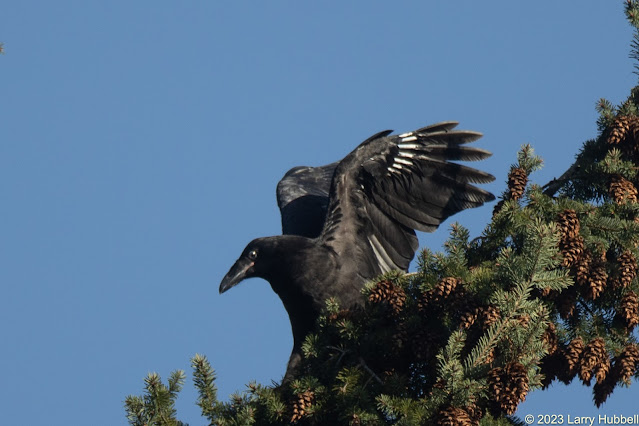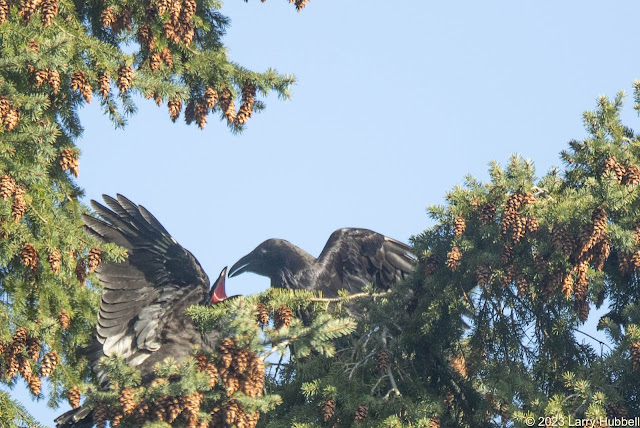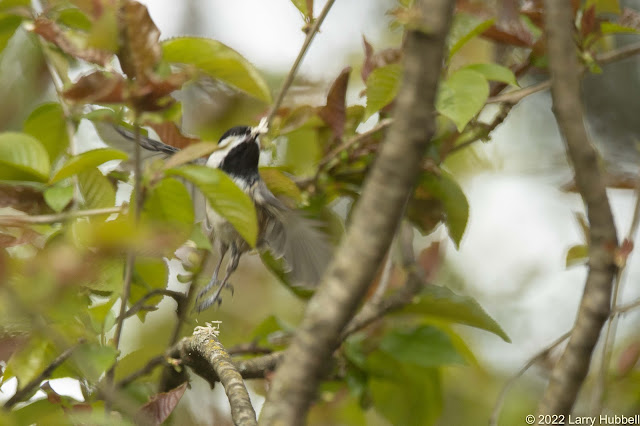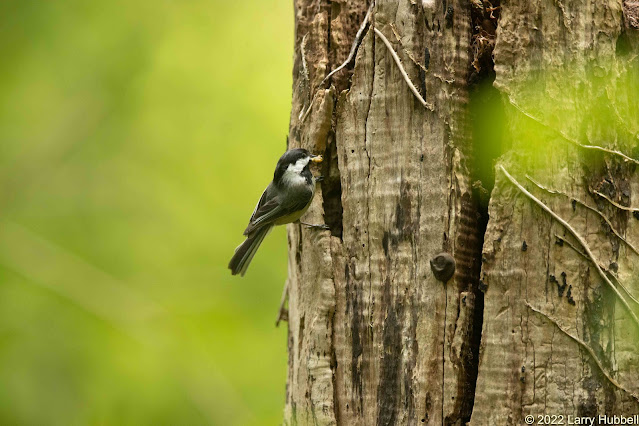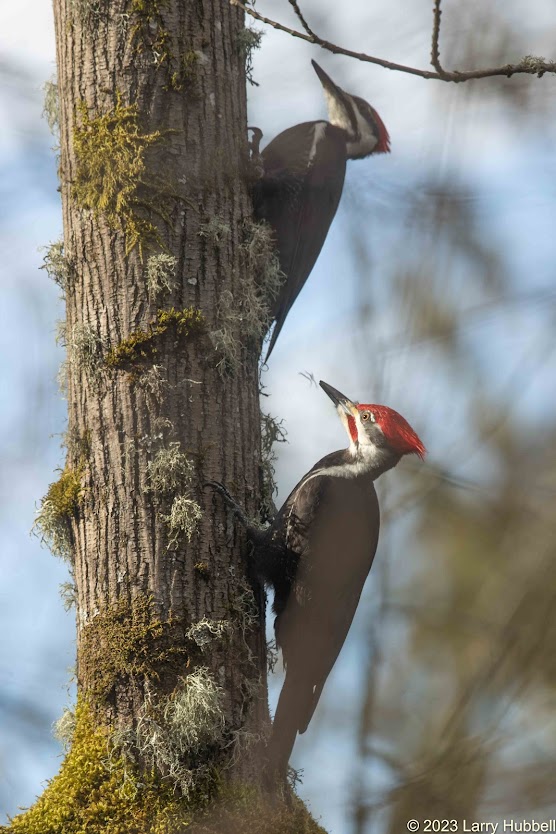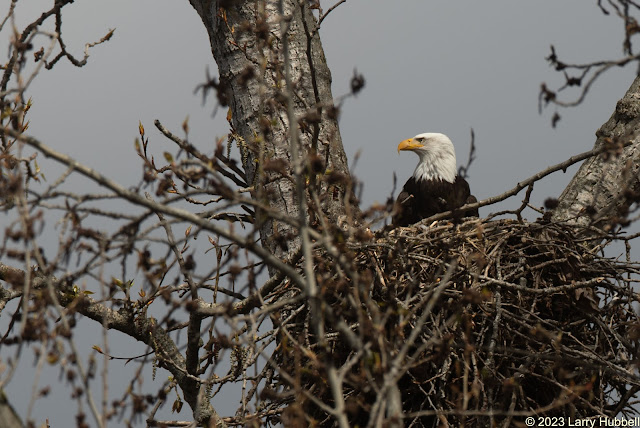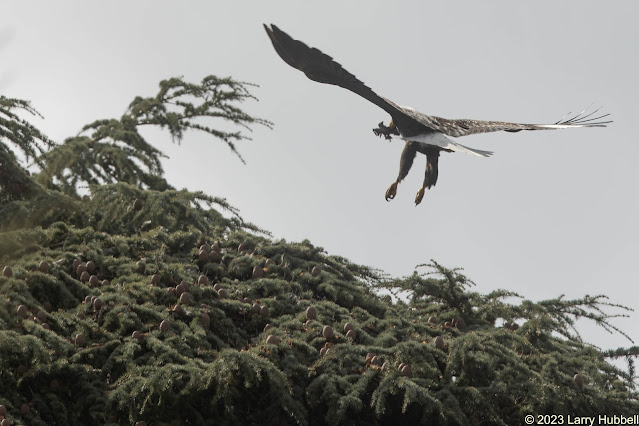
Given the preponderance of crows in Seattle, the average park visitor in the Arboretum might understandably assume that a distant blackbird, sitting on an upper branch in a Douglas Fir tree, is an adult American Crow.
In this case, a closer look reveals a small pink stripe on the inner portion of the bird's bill, which indicates it is actually a young bird. The long heavy bill and the nearly non-existent crown of the head inform us that it is not an American Crow but rather an immature Common Raven.
To the best of my knowledge, this is only the fourth Spring since Ravens have returned and resumed raising young in and around the Arboretum. I have seen no information that indicates Ravens nested in the area, before 2020, in either the 21st or the 20th centuries. I suspect their previous nearby nesting efforts occurred before the logging of old-growth timber in the later part of the 19th century.
During the last one hundred and twenty years many native trees flourished among the Arboretum collections and have grown to be over hundred feet tall. The fact that the Ravens have chosen older conifers as their nest sites, for the last four years, seems to validate the idea that tall trees are important as nest sites for the Ravens.
When the young raven turned and began walking back down the branch it exposed another age-related hint.
The bright white shafts of its primary feathers were fully displayed. In adult Ravens, these are hidden by their coverts, small black feathers, that cover the base of their primary feathers and help to create a seamless functional wing. This process of walking about among the branches, while young birds practice flapping their wings, is aptly referred to as 'branching".
In this video, one or two of the three young ravens can be seen working their wings on a branch just above the distant nest.
Back on the opposite side of the trunk the sibling, that we saw walking down the northern branch, quickly turns around when an adult approaches with food. The fledgling's excitement is made visible by the young bird flapping its wings, tipping its head back, and displaying its brightly-colored and wide-open mouth. These visual clues are the equivalent of the young raven begging, "Feed me, feed me".
Ravens are like humans in that they are omnivores. This adult may have been looking for fruit to feed to the young. In the past, I have seen them eating fruit, blossoms from Big Leaf Maple trees, meat from creatures that appeared to have been killed by Lake Washington Blvd traffic, and many other varied and unknown food sources.

This photo focuses on the south side of the tree trunk and shows a small portion of the mostly hidden nest at the bottom. Above the nest, and slightly to the left are the partial outlines of three young ravens. They can be seen (kind of) sitting side by side. Their natural camouflage and the secretive siting of the nest are obviously effective.
None of these three have demonstrated the ability to fly, that I have seen. However, their first flights could come at any time. In fact, I would not be surprised to discover an older sibling might have already flown the coup.
During the previous three years, I have documented that the adult Ravens had two, five, and three young, respectively. However, it is certainly possible I overlooked some additional offspring. This year, it is still early so I am cautiously stating, I think they have at least three young.
One of the more exciting moments this last week was when the neighboring Red-tailed Hawks appeared to encroach into the Ravens' territory. The Hawks nested nearby in Broadmoor. In previous weeks a young Red-tail could be heard begging for food, also in a tall Douglas Fir, but could never be seen. I suspect that the young hawk may have accidentally flown closer to the Ravens and as a result, the parents on both sides jumped into action.
It is interesting to compare the strikingly different shapes of their heads, wings, and tails in the photo above. The color difference is also obvious but depending on the light that is not always the case. The lighter-colored Red-tailed Hawk is on the left.
The photo below, of an American Crow, is intentionally small to provide an appropriately-sized comparison between the Raven (above on the right) and the Crow. Notice the shorter, and more rounded shape of the Crow's wings and the more wedge or diamond-shaped tail of the Raven, also the Raven's head and bill protrude more than those of the other two species.
The Raven was far more agile and dived repeatedly at the Red-tailed Hawk. The Hawk rolled over in mid-air to present its talons in defense.
Neither species was quick to leave the area.
I suspect strong parental motivation on both sides.
Here is another interesting comparison of their silhouettes. Notice the shape of the Raven's tail can change quite a bit depending on how it is held or used.
Ultimately, they decide to peacefully co-exist, which was probably a great relief for all involved.
As of today, these young ravens may have already left the nest. However, I suspect they are likely to hang around in the Arboretum for a few weeks. Most likely, they will slowly disperse to nearby places, like Interlaken Park, while spending less and less time with their parents. However, while this transition occurs they will be almost constantly begging for food and often traveling together in a small flock of siblings.
These calls were recorded in 2021. However, I anticipate if you visit the Arboretum during the next month or two you may hear similar sounds. I hope it is comforting to know these are not the sounds of people in pain or the weak cries of starving young Ravens. The volume with which they cry is the first clue to their adequate supply of food. Plus, I have heard them make the same exact sounds in between bites of food. As they mature they will learn to find their own food and learn there is value in doing so quietly.
Have a great day on Union Bay...where nature lives in the city and Black Birders are welcome!
Sincerely,
Larry
ps:
New! Article in the Seattle Times about improving your backyard habitat!
Each of us, who breathes the air, drinks water, and eats food should be helping to protect our environment. Local efforts are most effective and sustainable. Native plants and trees encourage the largest diversity of lifeforms because of their long intertwined history with our local environment and native creatures. Even the microbes in the soil are native to each local landscape.
I hope we can inspire ourselves, our neighbors, and local businesses to respect native flora and support native wildlife at every opportunity. I have learned that our most logical approach to native trees and plants (in order of priority) should be to:
1) Learn and leave established native flora undisturbed.
2) Remove invasive species and then wait to see if native plants begin to grow without assistance. (When native plants start on their own, then these plants or trees are likely the most appropriate flora for the habitat.)
3) Scatter seeds from nearby native plants in a similar habitat.
4) If you feel you must add a new plant then select a native plant while considering how the plant fits with the specific habitat and understanding the plant's logical place in the normal succession of native plants.
***************
My friend Elaine Chuang shared several resources (that were new to me) from the January 2022 Washington Ornithological Society meeting. By the way, Elaine credits Vicki King for researching and supplying this information. Keystone native plants are an important new idea. Douglas Tallamy in the book "Nature's Best Hope " explains that caterpillars supply more energy to birds than any other plant eater. He also mentions that 14% of our native plants, i.e. Keystone Plants, provide food for 90% of our caterpillars. This unique subset of native plants and trees enables critical moths, butterflies, and caterpillars that in turn provide food for the great majority of birds, especially during the breeding season.
Here are some relevant links.
A video all about native keystone plants for wildlife:
https://www.youtube.com/watch?v=O5cXccWx030
Resources for adding keystone native plants to your yard.
https://wos.org/wos-wp/wp-content/uploads/2022/10/Native-Plant-Resources-10-7-22.pdf
This updated collection includes a variety of new and different books, perspectives, and interactions between plants, birds, and insects. Thank you to Vicki King for continuing to collect all of these exceptionally helpful works. Also, thank you to each of the individuals who contributed.
***************
In the area below it is my intention to display at least one photo each week to help challenge us to know the difference between native and non-native lifeforms.
By the way, if you thought this butterfly looks like it is upside down - you are correct. The online source, click on the name below to read more, says these butterflies often feed on the sap of trees and will do so with their heads pointed down.
Scroll down for the answer.
******************
Mourning Cloak: Yes. It is native to both North America and Northern Eurasia. For an interesting explanation of the name
Click Here.
This butterfly, found later in the week, is holding its head up. From what I read, it is most likely not feeding, but rather waiting in the sunshine while hoping to attract a passing female.
*****************
The Email Challenge:
Over the years, I have had many readers tell me that Google is no longer sending them email announcements. As of 2021, Google has discontinued the service.
In response, I have set up my own email list. With each post, I will manually send out an announcement. If you would like to be added to my personal email list please send me an email requesting to be added. Something like:
Larry, Please add me to your personal email list.
My email address is:
LDHubbell@comcast.net
Thank you!
*******************
The Comment Challenge:
Another common issue is losing your input while attempting to leave a comment on this blog. Often everything functions fine, however, sometimes people are unable to make it past the robot-detection challenge or maybe it is the lack of a Google account. I am uncertain about the precise issue. Sadly, a person can lose their comment with no recovery recourse.
Bottom Line: If you write a long comment, please, copy it before hitting enter. Then, if the comment function fails to record your information, you can send the comment directly to me using email.My email address is:
LDHubbell@comcast.net
Sincerely,Larry




